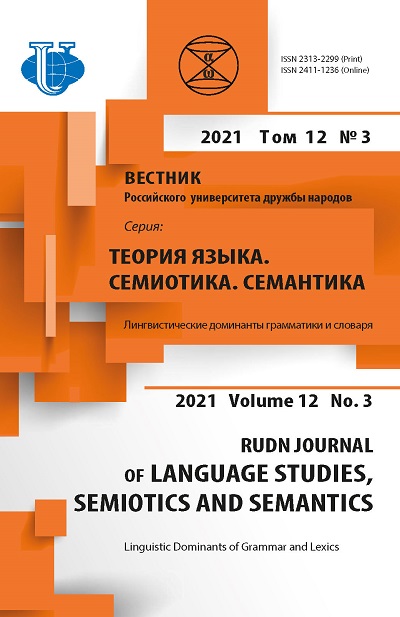The History of Semiotic Ideas: Victoria Lady Welby’s Significs
- Authors: Skripnik K.D.1
-
Affiliations:
- Southern Federal University
- Issue: Vol 12, No 3 (2021): Linguistic dominants of grammar and lexics
- Pages: 875-887
- Section: THEORY, METHODOLOGY AND HISTORY OF LINGUISTICS. SEMIOTICS AND LINGUOCULTUROLOGY
- URL: https://journals.rudn.ru/semiotics-semantics/article/view/27577
- DOI: https://doi.org/10.22363/2313-2299-2021-12-3-875-887
Cite item
Full Text
Abstract
The purpose of this article is to characterize the basic ideas of the conception of significs, the original science of sign and meaning that emerged at the turn of the 19th-20th centuries in the works of Victoria Lady Welby (1837-1912). The article explains the features of significs, which considers the meaning of verbal and non-verbal signs as a complex hierarchical structure, the levels of which are sense, meaning, and significance. Significance includes the preceding levels and takes into account their relations with axiological characteristics. The author points out that the content of the structure of “sense-meaning-significance” can be represented in different ways, depending on metaphorical, terminological, social and communicative factors. The conception of significs thus becomes universal and fundamental. The article emphasizes that significs highlights the dynamic nature of meaning, considering changes, that take place on each of its levels. The author sees in this fact the connection of significs with the evolutionary ideas contained in linguistics and natural science, and traces the process of formation of significs, arguing that its foundations lie in the description of various examples of the use of language, undertaken by V. Welby at the early stages of her research. The article is based on the study and comparative analysis of both the works of V. Welby herself and the commentary literature. In conclusion the author specifizes the value of the conception of significs as an integral dynamic theory of sign, meaning, and significance, which incorporates the various aspects of sign issues - from the logical and linguistic to the axiological and pragmatic ones, and indicates the ways of explication the impact of significs on the subsequent development of semiotic, philosophical, and linguistic researches.
Keywords
About the authors
Konstantin D. Skripnik
Southern Federal University
Author for correspondence.
Email: skd53@mail.ru
ORCID iD: 0000-0002-2150-1571
DSc. in Philology, Full Professor, the Department of the History of Foreign and Domestic Philosophy, Institute of Philosophy, and Social and Political Sciences
105/42, Bolshaya Sadovaya Str., Rostov-on-Don, Russian Federation, 344006References
- Eschbach, A. (1983). Significs as Fundamental Science. In: Welby, V. What is Meaning? Studies in the Development of Significance. Amsterdam: John Benjamins Publ.Co. pp. Ix—xxxii.
- Welby, V. (1883). Links and Clues. London: Macmillan & Co.
- Welby, V. (1893). Meaning and Metaphor. The Monist, 3(4), 510—525.
- Welby, V. (1896). Sense, Meaning and Interpretation. Mind, V(17), 24—37; 18, 186—202.
- Welby, V. (1897). Grains of Sense. London: J.M. Dent & Co.
- Welby, V. (1892). The Use of ‘Inner’ and ‘Outer’ in Psychology: Does the Metaphor Help or Hinder? In: A small collection of extracts bearing upon this question respectfully submitted to the International Congress of Experimental Psychology, August 1892. For private circulation. Grantham: W. Clarke (Late L. Ridge). (An Outsider).
- Welby, V. (1893). A Selection of Passages from ‘Mind’ (January 1876 to July 1892), ‘Nature’ (1870, and 1888 to 1892), ‘Natural Science’ (1892), bearing on changes and defects in the significance of terms and in the theory and practice of logic. (For private circulation only). Grantham: W. Clarke (Late L. Ridge) (1893a).
- Welby, V. (1898). Witnesses to Ambiguity: A Collection. Grantham: W. Clarke.
- Hardwick, Ch. S. (ed.) (1977). Semiotic and Significs. The Correspondence between Charles S. Peirce and Victoria Lady Welby. Bloomington & London: Indiana University Press.
- Petrilli, S. (2009). Signifying and Understanding. Berlin: De Gruyter Morton.
- Welby, V. (1983). What is Meaning? Amsterdam: John Benjamin Publ.Co.
- Welby, V. (1985). Significs and Language. Amsterdam: John Benjamin Publ.Co.
- Macdonald, D. (1964). Lady Welby. The Sociological Review, V, 152—156.
- Skripnik, K.D. (2019). Filosofskoe jepistoljarnoe nasledstvo: fenomen ledi Viktorii Ujelbi. Philosophy Journal, 12(2),131—143. (In Russ.).
- Cust, N. (ed.) (1929). Echoes of Larger Life: A Selection from the Early Correspondence of Victoria Lady Welby. London: Jonathan Cape.
- Cust, N. (ed.) (1931). Other Dimensions: A Selection from the Later Correspondence of Victoria Lady Welby. London: Jonathan Cape.
- Lieb, Irwin C. (ed.) (1955). Charles S. Peirce’s Letters to Lady Welby. New Haven: Whitlock’s Inc.
- Schmitz, Walter H. (ed.) (1990). Essays on Significs. Papers presented on the Occasion of the 150th Anniversary of the Birth of Victoria Lady Welby. Amsterdam: John Benjamins.
- Myers, W.A. (1995). Victoria, Lady Welby. In: Waithe, M.E. (ed.) A History of Women Philosophers. Vol. 4. Kluwer Academic Publishers. pp. 1—24.
- Dantzig, David Van. (1948). Significs, and Its Relation to Semiotics. In: M´elanges philosophiques. Vol. 2. (Library of the Xth International Congress of Philosophy. Amsterdam, 11—18 August 1948). Amsterdam: L. J Veen Ltd. pp. 176—189.
- Vuysje, D. (1953). Significs. Its Tendency, Methodology, and Applications. Proceedings of the American Academy of Arts and Sciences, 80(3), 223—270.
- Welby, V. (1933). Significs. In: Murray, A.H. et al. (eds.) A New English Dictionary on Historical Principles. Vol. IX. Oxford: Clarendon Press.
- Welby, V., Stout, G. & Baldwin, J. (1902). Significs. In: Baldwin, J. (ed.) Dictionary of Philosophy and Psychology in Three Volumes. Vol. 2. New York-London: Macmillan.
- Neubauer, D. (2013). Lady Welby: Significs and the Interpretative Mind. Semiotica, 196, 243—260.
- Jakobson, R.O. (1985). O lingvisticheskih aspektah perevoda. In: Selected works. Moscow: Progress. pp. 361—368. (In Russ.).
- Pirs, Ch. (2000). Issues of pragmatism. St. Petersburg: Aletejja. (In Russ.).
- Russell, B. (1959). My Philosophical Development. London: Georg Allen & Unwin Ltd.
- Morris, Ch. (1964). Signification and Significance. A Study of the Relations of Signs and Values. Cambridge: MIT Press.
- Mannoury, G. (1969). A Concise History of Significs. Methodology and Science, 2, 171—180.













